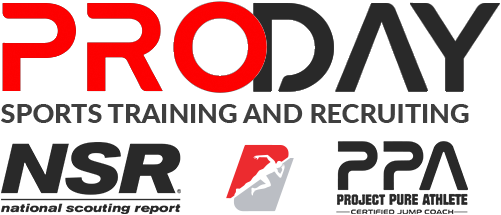Speed
Velocity
Sports that focus on velocity (VELO) the most are often outdoor sports like softball, baseball, and at times even soccer and lacrosse. This is the speed at which a projectile is exiting the player’s hand, foot, or sporting equipment. Indoor sports like volleyball can also benefit from hitting or serving speed. Larger increases will be seen from a combination of sports performance training as well as direction from qualified coaches private lessons. Simply put however sports performance training alone does show improvement among athletes as they are developing muscle growth in the classes followed by results in the combined VELO scores.
Best Practices / Preparation: For all sports, the radar gun will be positioned about 7 feet above the ground. Aim for the radar gun. The radar gun will find the fastest speed the ball has traveled.
Power
Kneeling Powerball Launch
Used in the NHL and NFL the Kneeling Powerball Throw (KBL) is a great skill to determine an athlete’s abilities to overpower a defender. Using a 4.5 Kilogram medicine ball the test involves mostly the athlete’s upper body with allowed rocking motion to launch the ball for maximum distance. Athletes are given 2 attempts and the furthest distance will be recorded.
Best Practices / Preparation: Optimal Launch Angle is 30-45 degrees. Athletes who fall forward, which is allowed, typically exert more effort/power during launch and therefore obtain further distance results.
Explosiveness
Approach Vertical Jump (AVJ)
The NBA and AFL and USAV all find an approach vertical off of either one or two feet to be useful in determining an athlete’s lower-body explosiveness through approach vertical Jump (AVJ) tests.
Best Practices / Preparation: upon practicing your approach it’s important that you reach the marker at the peak of your jump, additionally the speed at which you are moving horizontally and transferred upward with the cadence of using arm movement is important to maximizing you approach vertical jump score.
Standing Broad Jump (SBJ)
Most of our categories have a primary and secondary test however for explosiveness we have a tertiary test for forwarding momentum in the standing broad jump (SBJ). This test is used in the NFL.
Best Practices / Preparation: we often tell athletes that its beneficial to have a rocking motion that if performed properly should act almost a bit like a rubber band in exploding forward. We do allow athletes to fall back as if landing in a sandpit as long as their heel did not appear to move. If shortest heel moves the evaluator will mark short of their assessment so be sure to stick your landing.
Agility
Agility Lane Drill (ALD)
It was determined that a secondary alternative to the star drill would be a good sister drill to the Agility Star Drill as it covered a longer distance as well as 90 degree angles without having to touch a cone with your hand. It includes pure straight forward and backpedal movements north and south unseen in the star drill.
Best Practices / Preparation: First Step explosiveness when changing direction is key to performing well on this rill along with proper coordination. Stay as tight to the cones as possible without cutting corners and be sure to not cross your feet as this is a typical and immediate disqualification.
Reaction
React Shuttle Run (RSR)
Running right or left depending on the stimulus. The stimulus is one of two fit lights placed in front of the athlete. This type of reaction-based drill is also in initial testing for the NBA. The distance is the width of an NBA lane.
This drill is differentiated from the react 5-10-5 in that it is a shorter distance to travel and most importantly you do not have to touch the lines with your hand. Therefore, it’s best to visualize the drill being performed to perfection in which you simply have to cross the plane of the line with your foot for example. Often times athletes step well over the line by 1-2 feet, losing time in the process.
